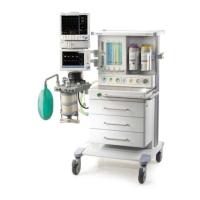AS3000™ Service Manual 0070-10-0683 2 - 9
Installation Guide Installation Checkout Procedure
5. Check N
2
O, O
2
and AIR Lines for leaks.
a. Remove the cylinders from the AS3000.
b. Connect the O
2
, AIR and N
2
O hoses to the gas line inlets.
NOTE: If a specific gas source is not available, skip the
corresponding leak test.
c. Verify O
2
, AIR and N
2
O Line Pressure gauges read the corresponding line pressure.
d. Set the AIR flow controller to minimum.
e. Pinch to occlude the O
2
, AIR and N
2
O hoses.
f. Disconnect each hose from its line pressure source.
g. Verify that the pressures do not drop more than 2 psi over a time period of 20
seconds.
6. Verify that all available line and cylinder gauges are operational.
a. Connect the O
2
supply hose and remove the AIR and N
2
O hoses.
b. Verify the O
2
Line Pressure gauge shows the reading of the line pressure.
c. Connect the AIR supply hose and remove the O
2
and N
2
O hoses.
d. Verify that the AIR Line Pressure gauges show the reading of the line pressure.
e. Connect the O
2
and N
2
O hoses and remove the AIR hose.
f. Verify that the N
2
O and O
2
Line Pressure gauge shows the reading of the line
pressure.
g. Attach the cylinders to the AS3000's yokes (O
2
and N
2
O or AIR). In the case
where multiple cylinders of the same gas are required, attach one at a time.
h. Open all attached cylinders including the O
2
cylinder. If a cylinders pressure is less
than 500 psi, replace the respective cylinder.
i. Verify that the cylinder pressure gauges register a pressure for each type of gas
attached.
7. Test O
2
Flush operation with only O
2
connected.
a. Connect the O
2
supply hose and remove the AIR and N
2
O hoses.
b. Attach a calibrated flow meter to the Common Gas Outlet.
c. Push the O
2
Flush button and verify a reading between 35 L/min and 50 L/min at
the flow meter.
NOTE: O
2
flow may be greater than 50 L/min at higher altitudes.
d. Reconnect the O
2
, AIR and N
2
O hoses.
8. Test the O
2
:N
2
O ratio system (applicable to -01 units only).
a. Set all flow control knobs to minimum.
b. Increase the flow of N
2
O until the O
2
reaches 1 L/min
c. Verify that the N
2
O flow is not higher than 3.7 L/min.
d. Return flow control knobs to minimum.

